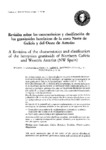Revisión sobre las características y clasificación de los granitoides hercínicos de la zona Norte de Galicia y del Oeste de Asturias

View/
Use this link to cite
http://hdl.handle.net/2183/5991Collections
Metadata
Show full item recordTitle
Revisión sobre las características y clasificación de los granitoides hercínicos de la zona Norte de Galicia y del Oeste de AsturiasAlternative Title(s)
A Revision of the characteristics and clasification of the hercynian granitoids of Northern Galicia and Western Asturias (NW Spain)Author(s)
Date
1987Citation
Cadernos do Laboratorio Xeolóxico de Laxe, 1987, 11: 241-260 ISSN: 0213-4497
Abstract
[Resumen] Este trabajo resume parte de los resultados obtenidos en el desarrollo del proyecto «Caracterización y correlación petrológica, geoquímica y geocronológica de las rocas graníticas de Galicia (A Coruña-Lugo)>>, realizado por el 1. ~G. M. E. El estudio sistemático de los distintos plutones graníticos de esta región ha puesto de manifiesto que los criterios de clasificación tradicionalmente utilizados en este ámbito geológico, presentan una serie de limitaciones debidas por una parte a la rigidez de los grupos establecidos y por otra, a las características transicionales de algunas unidades plutónicas. Estos hechos permiten suponer que las relaciones entre los «granitoides alcalinos y alumínicos de dos micas» y los «granitoides de tendencia calcoalcalina» no son tan independientes como se ha venido considerando en los modelos preexistentes. En función de la profundidad y etapa de emplazamiento y de las características petrológicas, las distintas unidades se han agrupado en las siguientes familias:
- Granitoides sincinemáticos de emplazamiento relativamente profundo.
- Granitoides sincinemáticos de emplazamiento somero.
- Granitoides postcinemáticos de emplazamiento somero.
Asimismo se detectan unidades plutónicas complejas, constituidas por varios granitos, a los cuales les corresponderían génesis diferentes, si se siguiesen los criterios previamente vigentes. [Abstract] This article summarizes part of the results of the project «Petrological, geochemical and geochronological caracterization and correlation of the granitic rocks of Galicia (provinces of A Coruña-Lugo)>>, executed on behalf of the Spanish Institute of Geology and Mining (1. G. M. E.). The Systematic investigation of the different granite plutons of the area evidences that the application of the criteria traditionally used for the classification of the granitic rocks in Galicia meets with serious difficulties. These are due to the rigidity of the established groups on the one hand and the transitional character of a number of plutonic units on the other hand. The study suggests that the relationship among the {<a1caline and aluminous two-mica granites» and the granitoids of the «ca1c-a1caline tendency is less independent than assumed in the hitherto used classification schemes and petrogenetical models. As a function of the depth and time of their emplacement and their petrological features, the different plutonic units are grouped into the following families:
- Synkinematic, relatively deep-seated granitoid bodies.
- Synkinematic, shallow-level granitoid bodies.
- Postkinematic, shallow-level granitoid bodies.
Attention is drawn to the occurrence of complex plutonic units whose constituent members would, according to the criteria of the pre-existing classification schemes, be petrogenetically unrelated or poorly related.
Keywords
Granitoides
Galicia
Hercínico
Tectónica
Mineralizaciones
Magmatismo
Granitoids
Hercynian
Tectonics
Mineralizations
Magmatism
Galicia
Hercínico
Tectónica
Mineralizaciones
Magmatismo
Granitoids
Hercynian
Tectonics
Mineralizations
Magmatism
ISSN
0213-4497





